美国科幻电影发展史英文版介绍
- 格式:doc
- 大小:27.00 KB
- 文档页数:3
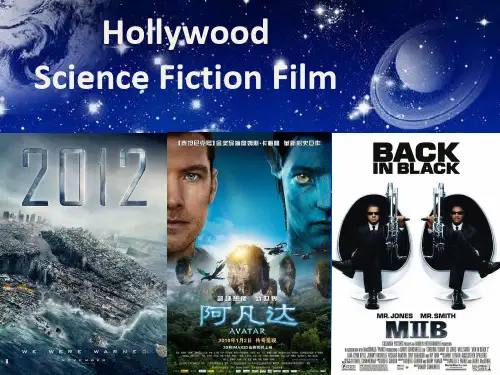

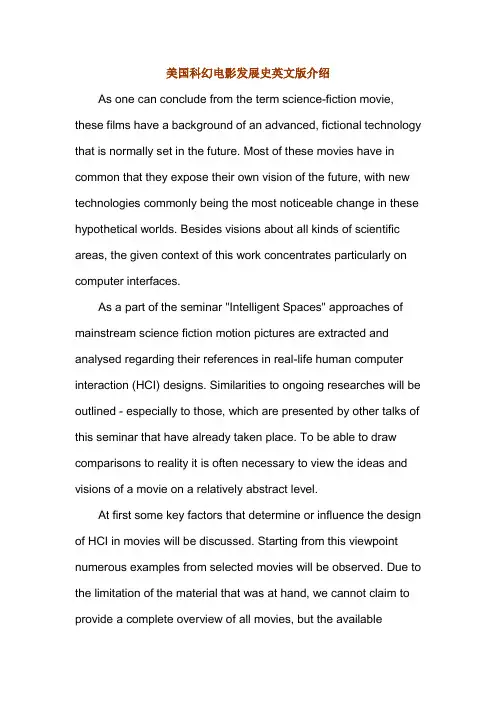
美国科幻电影发展史英文版介绍As one can conclude from the term science-fiction movie, these films have a background of an advanced, fictional technology that is normally set in the future. Most of these movies have in common that they expose their own vision of the future, with new technologies commonly being the most noticeable change in these hypothetical worlds. Besides visions about all kinds of scientific areas, the given context of this work concentrates particularly on computer interfaces.As a part of the seminar "Intelligent Spaces" approaches of mainstream science fiction motion pictures are extracted and analysed regarding their references in real-life human computer interaction (HCI) designs. Similarities to ongoing researches will be outlined - especially to those, which are presented by other talks of this seminar that have already taken place. To be able to draw comparisons to reality it is often necessary to view the ideas and visions of a movie on a relatively abstract level.At first some key factors that determine or influence the design of HCI in movies will be discussed. Starting from this viewpoint numerous examples from selected movies will be observed. Due to the limitation of the material that was at hand, we cannot claim to provide a complete overview of all movies, but the availableselection should suffice and allow a representative inspection of the movie scene.We will start with a review of movies that do not show any concepts at all or merely adapt common everyday techniques of that time. The second and main part introduces visionary interaction design, divided into different areas of interaction technologies, followed by a brief view at a couple of satiric movie scenes and the conclusions of this work in the end.。
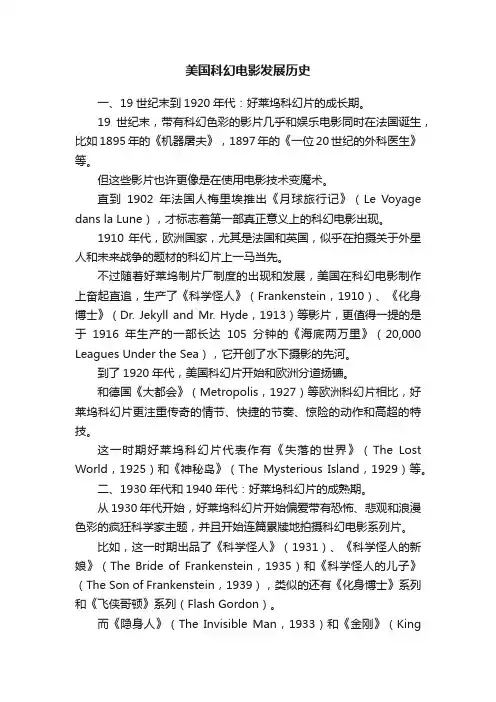
美国科幻电影发展历史一、19世纪末到1920年代:好莱坞科幻片的成长期。
19世纪末,带有科幻色彩的影片几乎和娱乐电影同时在法国诞生,比如1895年的《机器屠夫》,1897年的《一位20世纪的外科医生》等。
但这些影片也许更像是在使用电影技术变魔术。
直到1902年法国人梅里埃推出《月球旅行记》(Le Voyage dans la Lune),才标志着第一部真正意义上的科幻电影出现。
1910年代,欧洲国家,尤其是法国和英国,似乎在拍摄关于外星人和未来战争的题材的科幻片上一马当先。
不过随着好莱坞制片厂制度的出现和发展,美国在科幻电影制作上奋起直追,生产了《科学怪人》(Frankenstein,1910)、《化身博士》(Dr. Jekyll and Mr. Hyde,1913)等影片,更值得一提的是于1916年生产的一部长达105分钟的《海底两万里》(20,000 Leagues Under the Sea),它开创了水下摄影的先河。
到了1920年代,美国科幻片开始和欧洲分道扬镳。
和德国《大都会》(Metropolis,1927)等欧洲科幻片相比,好莱坞科幻片更注重传奇的情节、快捷的节奏、惊险的动作和高超的特技。
这一时期好莱坞科幻片代表作有《失落的世界》(The Lost World,1925)和《神秘岛》(The Mysterious Island,1929)等。
二、1930年代和1940年代:好莱坞科幻片的成熟期。
从1930年代开始,好莱坞科幻片开始偏爱带有恐怖、悲观和浪漫色彩的疯狂科学家主题,并且开始连篇累牍地拍摄科幻电影系列片。
比如,这一时期出品了《科学怪人》(1931)、《科学怪人的新娘》(The Bride of Frankenstein,1935)和《科学怪人的儿子》(The Son of Frankenstein,1939),类似的还有《化身博士》系列和《飞侠哥顿》系列(Flash Gordon)。
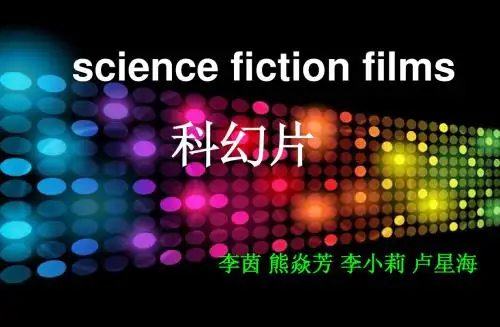

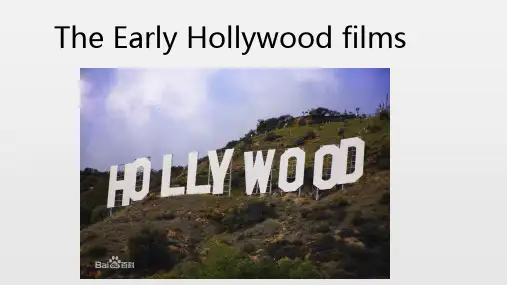
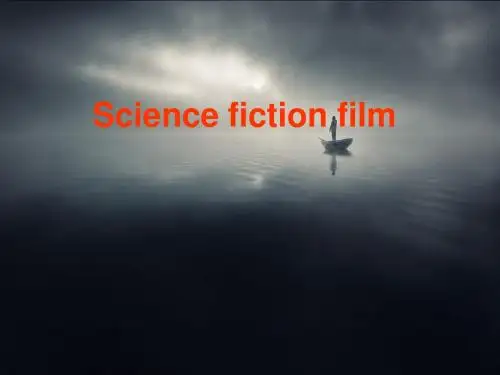
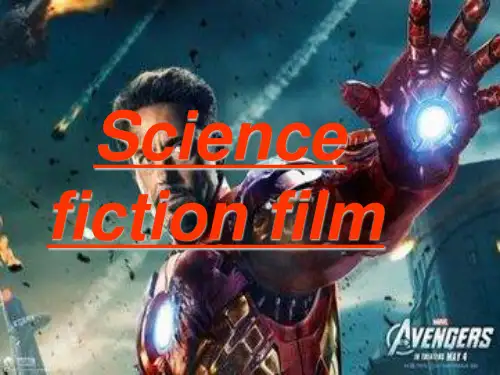
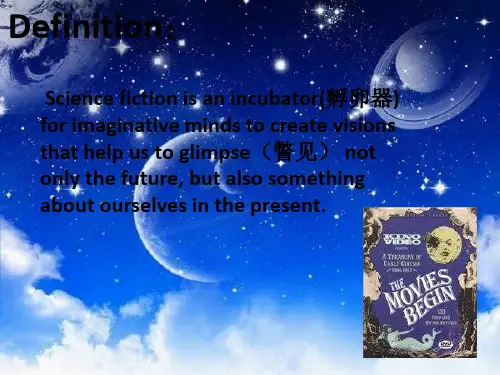
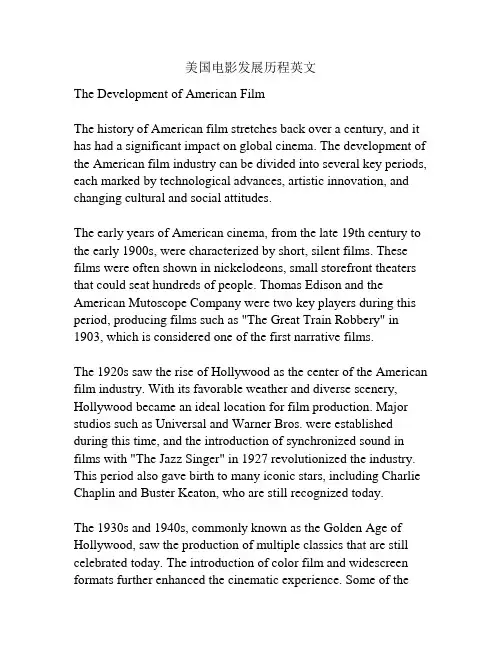
美国电影发展历程英文The Development of American FilmThe history of American film stretches back over a century, and it has had a significant impact on global cinema. The development of the American film industry can be divided into several key periods, each marked by technological advances, artistic innovation, and changing cultural and social attitudes.The early years of American cinema, from the late 19th century to the early 1900s, were characterized by short, silent films. These films were often shown in nickelodeons, small storefront theaters that could seat hundreds of people. Thomas Edison and the American Mutoscope Company were two key players during this period, producing films such as "The Great Train Robbery" in 1903, which is considered one of the first narrative films.The 1920s saw the rise of Hollywood as the center of the American film industry. With its favorable weather and diverse scenery, Hollywood became an ideal location for film production. Major studios such as Universal and Warner Bros. were established during this time, and the introduction of synchronized sound in films with "The Jazz Singer" in 1927 revolutionized the industry. This period also gave birth to many iconic stars, including Charlie Chaplin and Buster Keaton, who are still recognized today.The 1930s and 1940s, commonly known as the Golden Age of Hollywood, saw the production of multiple classics that are still celebrated today. The introduction of color film and widescreen formats further enhanced the cinematic experience. Some of themost revered films of this era include "Gone with the Wind" (1939) and "Casablanca" (1942). Additionally, Hollywood played an essential role in boosting morale during World War II, producing patriotic films that reflected the nation's spirit.In the 1950s, the rise of television posed a significant challenge to the film industry. To combat declining attendance, Hollywood responded with widescreen formats like Cinemascope and 3D, as well as epic spectacles such as "Ben-Hur" (1959). This period also saw the emergence of new genres, including science fiction and horror, with films like "Invasion of the Body Snatchers" (1956) and "Psycho" (1960).The 1970s witnessed a shift in American filmmaking, with the rise of independent cinema and the New Hollywood movement. Directors such as Martin Scorsese, Steven Spielberg, and Francis Ford Coppola brought a level of artistic and narrative complexity that challenged traditional storytelling conventions. Films such as "Taxi Driver" (1976), "Jaws" (1975), and "The Godfather" (1972) captured the attention of both critics and audiences, earning critical acclaim and box office success.In recent decades, American cinema has continued to evolve and diversify. Hollywood has seen the emergence of blockbuster franchises and superhero films, as well as a growing focus on representation and inclusion, showcasing stories from underrepresented communities. Independent filmmaking has thrived, often pushing boundaries and exploring new narratives.In conclusion, the development of American film is a testament tothe innovative spirit, cultural influence, and global reach of the industry. From the early silent films to the present-day blockbusters, American cinema has continuously evolved, reflecting the changing tastes and values of audiences worldwide.。
科幻电影简介英语作文50词英文回答:In the realm of science fiction, where imagination reigns supreme and technological advancements push the boundaries of possibility, a cinematic masterpiece emerges.A breathtaking fusion of science, innovation, philosophy, and human emotion, this film transports viewers to a realm where dreams and nightmares intertwine.At the heart of this extraordinary narrative lies a protagonist who embarks on an epic journey. Driven by a thirst for knowledge, a desire for adventure, or a yearning for redemption, they venture into uncharted territories, encountering both wonder and peril. Alongside a cast of enigmatic companions, they navigate treacherous landscapes, face formidable adversaries, and grapple with the profound implications of their discoveries.Through the lens of a visionary director, the filmexplores timeless themes of identity, purpose, and the indomitable spirit of humanity. It delves into the complexities of consciousness, the nature of reality, and the ethical dilemmas posed by scientific progress. With stunning visuals, thought-provoking dialogue, and an immersive soundscape, it invites viewers to question their own beliefs and ponder the trajectory of human existence.In an era marked by technological advancements that reshape our world, this film serves as a potent reminder of the transformative power of imagination. It inspires us to embrace the unknown, push the boundaries of our intellect, and strive for a future where science and humanity coexistin harmony.中文回答:在科幻电影的世界里,想象力至高无上,技术进步不断突破可能性的界限,一部电影杰作由此诞生。
美国科幻电影发展史英文版介绍As one can conclude from the term science-fiction movie, these films have a background of an advanced, fictional technology that is normally set in the future. Most of these movies have in common that they expose their own vision of the future, with new technologies commonly being the most noticeable change in these hypothetical worlds. Besides visions about all kinds of scientific areas, the given context of this work concentrates particularly on computer interfaces.As a part of the seminar "Intelligent Spaces" approaches of mainstream science fiction motion pictures are extracted and analysed regarding their references in real-life human computer interaction (HCI) designs. Similarities to ongoing researches will be outlined - especially to those, which are presented by other talks of this seminar that have already taken place. To be able to draw comparisons to reality it is often necessary to view the ideas and visions of a movie on a relatively abstract level.At first some key factors that determine or influence the design of HCI in movies will be discussed. Starting from this viewpoint numerous examples from selected movies will be observed. Due to the limitation of the material that was at hand, we cannot claim to provide a complete overview of all movies, but the available selection should suffice and allow a representative inspection of the movie scene.We will start with a review of movies that do not show any concepts at all or merely a dapt common everyday techniques of that time. The second and main part introduces visionary interaction design, divided into different areas of interaction technologies, followed by a brief view at a couple of satiric movie scenes and the conclusions of this work in the end.First, the 19th to in the 1920s, Hollywood sci-fi growth. 19 century, with the science fiction film of color film also almost and entertainment, was born in France, for example in 1895 "machine", the 1897 butcher "a 20th century surgeon", etc. But these movies, perhaps more like film technology in use of magic. Until 1902 French launched the trip to the moon meili ella record "(Le Voyage dans la Lune), just marked the first real sense of science fiction movie appear. In 1910, European countries, especially France and Britain, it seems that the filming of alien and future war theme befriends the lead on. But with Hollywood studios system's appearance and development, the United States in science fiction filmproduction, and produced on catching Frankenstein (Frankenstein, 1910, the incarnation Dr Jekyll and "(Dr. Mr. J, 1913) films Hyde, more remarkably in 1916 production of a minister of 105 minutes of the seabed 20,000 miles" (20,000 Leagues Under the Sea), it heralds the beginning of underwater photography. Arrived in the 1920s, the United States and Europe separate. Start sci-fi And Germany "Metropolis" (Metropolis, 1927) and other European science fiction, compared to Hollywood legend of paying more attention to science fiction plot, fast rhythm, breathtaking action and superb stunts. This period Hollywood sci-fi inclue The Lost World "(The World Lost, 1925) and The Mysterious Island (The Mysterious Island, 1929), etc. Second, the 1930s and 1940s, Hollywood sci-fi mature. Start from the 1930s Hollywood science fiction begin with terror, pessimistic preference and romantic colorific mad scientist theme, and began to shoot science fiction movie endless series. For example, this period produced Frankenstein (1931), The scientific weirdo Bride "(The Bride of Frankenstein, 1935) and science screwball Son" (The companies of Frankenstein, 1939), as are The embodiment "series and The xia dr Gordon" series (Flash Gordon). But "The Invisible Man" (The Invisible Man, 1933) and "King Kong" (King Kong, 1933) are masterpieces produced at that time, they continue to develop Hollywood movies in special use and plot arrangement's strengths, and has produced unique program. Arrived in The 1940s, due to The effects of world war ii, Hollywood science fiction in a immobilized but relatively stable state, in this decade is almost always a production befriends formerly, The theme of "following series", for instance, The stealth women "(The Invisible ', 1940)," The Invisible Man Returns "(The Invisible Man Returns, 1940) and" The Invisible Man Revenge record "(The Invisible Man 's Revenge, 1944). However, this also strengthened Hollywood befriends the narrative mode. In 1943, released on "Batman (The Batman), Japanese scientists become evil adversaries, Hollywood science fiction and war propaganda combine together, this also is this period characteristic. Third, the 1950s and 1960s: Hollywood befriends the boom. In the 1950s, perhaps is cold war shrouded in psychological fear shadows to strengthen people's imagination, Hollywood during this period produce a lot of science fiction bestseller, they often in an alien, monster or wars as the theme, also more dependent on the use of stunts. Such as The Day The Earth Stood Still "(The Earth Stood Still, / The 1951), The X radiation" (- 1953), The!, The monster 20,000 Fathoms "(The Beast - 20,000 Fathoms, 1953), The Martian Invasion" (Invaders - Mars, 1953), The alien War Earth "(The court allows of The Worlds, 1953), The stolen corpse invade" (Invasion of The Body Snatchers, 1956), The planets adventure "(Forbidden invest, 1956)," flies "(The Fly, 1958) and tells The nuclear War" (On The seashore ok, 1959), etc. The influence of cold war on Hollywood sci-fi continued in the 1960s, such as in 1968 moon record "(" space with the Countdown) u.s.-soviet arms race for the source of imagination. But it is in the 1960s, produced in the history of science fiction classic 2001: A Space Odyssey (2001: A receiverby Odyssey, 1968). The British and American films had both in the story line and ideological content or special effects are achieved considerable height. Four, 1970s and 1980s: Hollywood stunt and in science fiction story balance between the age. Special use for Hollywood science fiction character never to be significant, and with the visual effect technology development, the stunt and stories of the tension between gradually began to increase. What do will both perfectly combine? Many directors made their attempt. George Lucas (George Lucas) "THX1138" (THX1138, 1971) and Star Wars (1977), Star altogether, Woody Allen (Woody Allen's sport in the fool with science city "(Sleeper, 1973), Steven Spielberg (Steven Spielberg) Close Encounters of the Third Kind (Close Encounters of the Kind, 1977) and makkah Bradley Scott" aliens "(essential, 1979) is undoubtedly 1970s several successful examples. At the beginning of the 1980s and the 1980s, Hollywood sci-fi special effects for making brings undreamed-of magical experience, and at the same time these science fiction films and provide them a worthy of taste story. Such as George Lucas in 80 years and 83 launched baronial imposing manner of The Star Wars of The Empire Strikes Back, (Star altogether: The foundation trilogy "cross-face drivers) and The Star Wars of The Return of The jedi (Star altogether: pressing of The Jedy), Steven spielberg's smoldering" ET alien "(E.T. The Extra Terrestrial, 1982) -, James Cameron (James Cameron) of The Terminator (The Terminator, 1984), and Robert Zemeckis ze meters Keith (Robert)" Back to The Future "(Back to The Future, 1985), etc. Five, since 1990, Hollywood science fiction in high-tech exploring the way forward along with the computer technology, the application of Hollywood sci-fi started mass rely on computer synthesis images (CGI), and its play extremely, but at the same time ignores the story itself importance. After 1990s Hollywood in science fiction story fareed zakaria, visual effect is in the very great impact, the picture is more exquisite realistic. "Independence day", "Jurassic park" series, Star Wars prequel "first (Star altogether: Episode I - The Phantom through, 1999) and The second part (Star Episode II - STH altogether: of The Clones, 2002) films will cultivate right audience who expensive stunt big occasion even started commonplace to rise. When dizzying computer special effects on the screen tend to glut, Hollywood sci-fi also began to lose their orientation. With the progress of science and technology, Hollywood sci-fi began to explore new themes, such as cloning technology and intelligent robot on human society profound influence.。